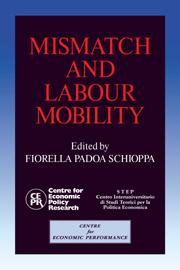Book contents
- Frontmatter
- Contents
- List of figures
- List of tables
- Preface
- Acknowledgements
- List of conference participants
- 1 A cross-country comparison of sectoral mismatch in the 1980s
- 2 Mismatch: a framework for thought
- Discussion
- 3 Match and mismatch on the German labour market
- Discussion
- 4 Mismatch in Japan
- Discussion
- 5 Mismatch and internal migration in Spain, 1962–86
- Discussion
- 6 Regional inequalities, migration and mismatch in Italy, 1960–86
- Discussion
- 7 Skill shortages and structural unemployment in Britain: a (mis)matching approach
- Discussion
- 8 Labour market tightness and the mismatch between demand and supply of less-educated young men in the United States in the 1980s
- Discussion
- 9 Skill mismatch, training systems and equilibrium unemployment: a comparative institutional analysis
- Discussion
- 10 Unemployment, vacancies and labour market programmes: Swedish evidence
- Discussion
- 11 Mismatch and labour mobility: some final remarks
- Index
4 - Mismatch in Japan
Published online by Cambridge University Press: 05 October 2010
- Frontmatter
- Contents
- List of figures
- List of tables
- Preface
- Acknowledgements
- List of conference participants
- 1 A cross-country comparison of sectoral mismatch in the 1980s
- 2 Mismatch: a framework for thought
- Discussion
- 3 Match and mismatch on the German labour market
- Discussion
- 4 Mismatch in Japan
- Discussion
- 5 Mismatch and internal migration in Spain, 1962–86
- Discussion
- 6 Regional inequalities, migration and mismatch in Italy, 1960–86
- Discussion
- 7 Skill shortages and structural unemployment in Britain: a (mis)matching approach
- Discussion
- 8 Labour market tightness and the mismatch between demand and supply of less-educated young men in the United States in the 1980s
- Discussion
- 9 Skill mismatch, training systems and equilibrium unemployment: a comparative institutional analysis
- Discussion
- 10 Unemployment, vacancies and labour market programmes: Swedish evidence
- Discussion
- 11 Mismatch and labour mobility: some final remarks
- Index
Summary
Tokyo is the information center of the country, where both the service industry and the international functions are concentrated. A place that is not linked up with Tokyo is bound to decline (free translation from Haruo, Shimada, Nikon Keizai Shinbun, 22 May 1989).
Introduction
Since the end of the 1970s, high (10% and more) and persistent unemployment has been a major issue in Europe. During the same period, Japanese unemployment increased from a very low 2% level to a temporary peak of 3% in the first half of 1987 (after the ‘endaka’ shock). This very low unemployment rate, accompanied with some specific features of the Japanese labour market such as the bonus system and the large size of the secondary sector, has induced many observers to consider Japan as a ‘no problem’ country, at least as far as unemployment is concerned.
This emphasis on the low level of unemployment (and the possible measurement issues involved) overlooks the fact that Japan, despite wage flexibility, the bonus system and the procyclical labour supply, which have all helped reduce the impact of exogenous shocks on the unemployment rate, has witnessed during the past ten years or so a significant increase in the NAIRU (see Hamada and Kurosaka, 1986 and the references therein), with unemployment showing the same sort of persistency exhibited by the major European economies (see Brunello, 1989 and the references therein).
Economic theory offers two main explanations of the current increase in the NAIRU in most developed countries (for the United States see Summers, 1986 and Topel and Murphy, 1987).
- Type
- Chapter
- Information
- Mismatch and Labour Mobility , pp. 140 - 179Publisher: Cambridge University PressPrint publication year: 1991
- 2
- Cited by



